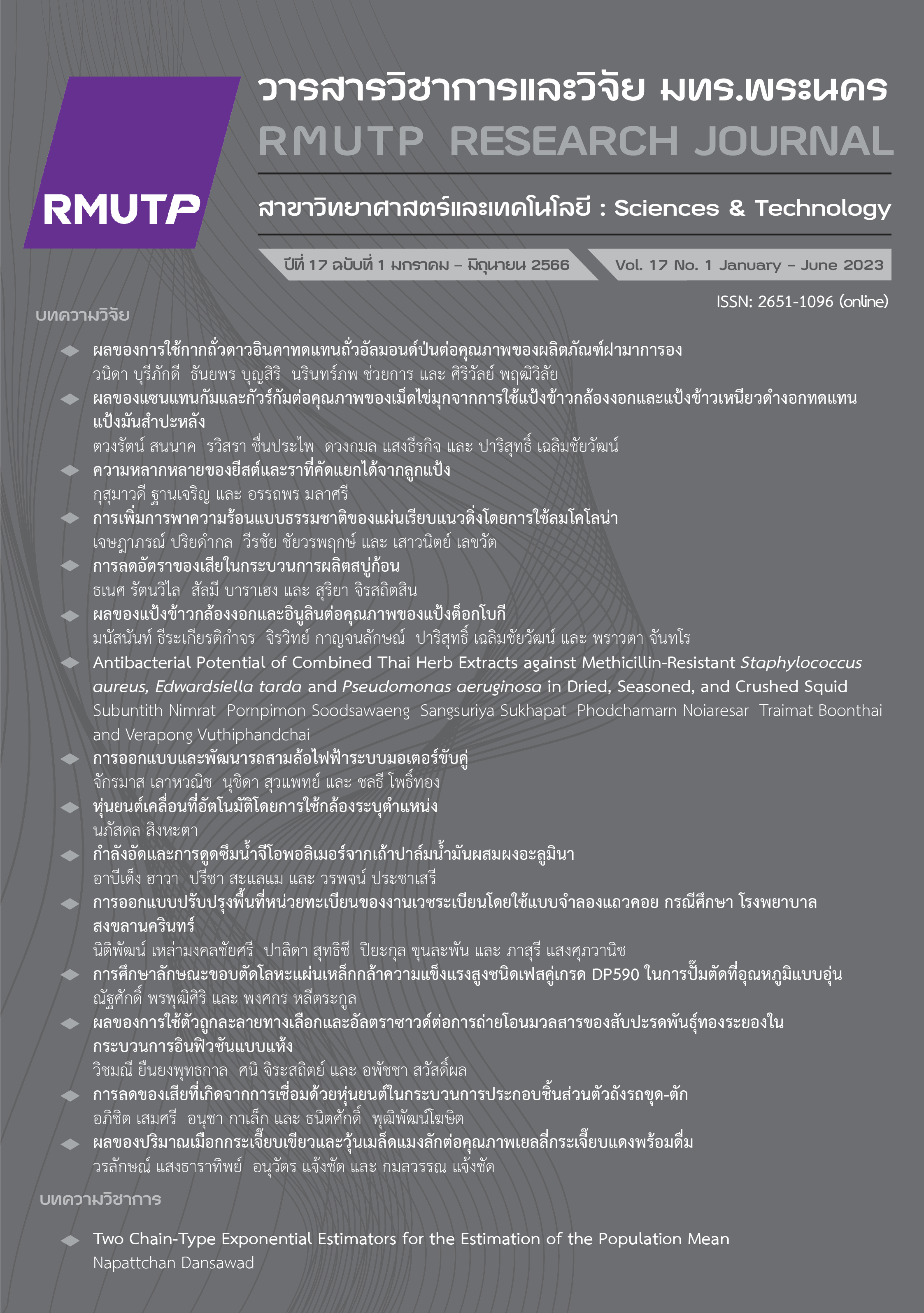Reduction of Defect Rate in Bar Soap Manufacturing Process
Main Article Content
Abstract
The growth of bar soap industry leads to an increasing productivity improvement of bar soap manufacturing process to reduce the defect rate. The appropriated quality tools such as fish bone diagram and why-why analysis were adopted to find the cause of defect and to improve the manufacturing process associated with the brain-storming technique. The research objective is therefore to reduce the defect rate in the bar soap manufacturing process. Based on the current manufacturing process, it was found that the defect rate was caused by the belt conveyor. The data collection was conducted and analyzed to find the route cause using pareto diagram and found that the highest defect rates are caused by the clogging soap on the roller surface and the slipping guide behind the conveyor belt, respectively with the total defect of 8,837 kg (65.35 percent). Those two major causes were subsequently analyzed and created the plans to solve the problems, implement the plans, conclude the results, and finally set the standard procedures. After implementation, the result shows that the defect rate of bar soap manufacturing process is significantly reduce 8.8% from 12.5% to 3.7% per month (P < 0.05) whereas the quality rate is also significantly increased from 87.4% to 96.3% per month. The decreasing defect rate is achieved the target of the research purpose.
Article Details

This work is licensed under a Creative Commons Attribution-NonCommercial-NoDerivatives 4.0 International License.
ลิขสิทธ์ ของมหาวิทยาลัยเทคโนโลยีราชมงคลพระนครReferences
Department of Trade Negotiations. (2021, March). Cosmetics, soaps and skin care products. [Online]. Available: https://www.
ditp.go.th/contents_attach/732611/732611.pdf
Department of Trade Negotiations. (2020, April). Expanding the soap market with FTA: Opportunities for the Thai soap industry during the Coronavirus Disease 2019 crisis. [Online]. Available: https://api.dtn.go.th/files/v3/5ea141c6ef4140efbb1e54f4/download
L. Spitz, Soap Manufacturing Technology, 2nd ed. Academic Press and AOCS Press, 2016.
P. Pornprasert, A. Pornprasert and D. Utarapong, “Defects rate reduction in the engine liquid pipelines manufacturing by dimension inspector jig improvement: a case study of automotive part manufacturing,” Journal of Industrial Technology Ubon Ratchathani Rajabhet University, vol. 6, no. 1, pp. 163-176, July 2016.
P. Pukasorn, S. Srichaluai and P. Pougchampul, “Study and reducing waste in the injection molding process,” in Proceedings of the Conference of Industrial Engineering Network 2012, Sripatum University, Petchaburi, 2012, pp. 859-866.
S. Saewong, “Reduction of defect rate in shrimp feed process,” M.Eng. minor thesis, Dept. Ind. Eng., Prince of Songkla Univ., Songkhla, Thailand, 2011.
T. Sunseang, “Waste reduction in injection process,” M. Eng. thesis, Dept. Eng Mgt., Dhurakij Pundit Univ., Bangkok, Thailand, 2014.
G. Olmi, “Statistical tools applied for the reduction of the defect rate of coffee degassing valves” Case Studies in Engineering Failure Analysis, vol. 3, pp. 17-24, 2015.
A. Joshi and L.M. Jugulkar, “Investigation and analysis of metal casting defects and defect reduction by using quality control tools” in Proceedings of IRF International Conference, Goa, 2014, pp. 86-91. March 2014.
P. Hormsri and J. Khongthana, “Defects reduction in the process of automotive injection plastic part by using design of experiment (DOE),” Journal of Engineering, vol. 2, pp. 11-28, Dec. 2014.
K. Athikulrat and S. Yindeemorh, “Application of Six Sigma to reduce waste from wire spokes production process: A case study on motorcycle parts factory,” KMUTT Research and Development Journal, vol. 43, no. 3, pp. 277-296, Jul. 2020.
Amnaht Amaluk, “Defect reduction in machine parts production processes: A case study of Supreme Precision Manufacturing Co.,Ltd.,” Thai Industrial Engineering Network Journal, vol. 5, no. 1, pp. 36-48, Jan. 2019.
Ch. Thavornwat, R. Kanchana, S. Jarupinyo and V. Wattanajitsiri, “The defect reduction in wire parts process for car seat,” Thai Industrial Engineering Network Journal, vol. 3, no. 1, pp. 25-33, Jan. 2017.
K. Kitpongnikorn and N. Osothsilp, “Defect reduction in film blowing process by Six Sigma approach,” Srinakharinwirot University Engineering Journal, vol. 13, no. 1, pp. 187-201, Jan. 2018.
K. AthiKulrat and K. Dolpanya, “Defective reduction in the production process of plastic films,” Science and Technology Nakhon Sawan Rajabhat University Journal, vol. 11, no. 13, pp. 41-50, Jan. 2019.
N. Maneechot and Ph. Pijitbanjong, “Defect reduction in standard thai rubber production process,” Thai Industrial Engineering Network Journal, vol. 5, no. 1, pp. 66-74, Jan. 2019.
T. Ratanawilai and V. Srisuk, “Improvement of overall equipment effectiveness on the process of wood plank,” Naresuan University Journal: Science and Technology, vol. 23, no. 1, pp. 133-141, Jan. 2015.
P. Klomjit, Productivity Improvement: Principle and Practice, Bangkok, Se- Education, 2014.


